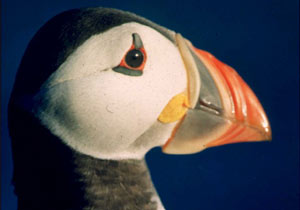
A Puffin - their habitat is under threat from oil exploitation in St Kilda, Scotland
The nutrient rich waters of the Atlantic Ocean west of Scotland are of global significance for
marine wildlife. It is here where cold arctic waters meet the warm Gulf Stream, and where the
shallow UK continental shelf drops into the Atlantic ocean forming submarine mountains and
canyons.
The area has been described as a "whale motorway" for migrating species, and is now known to
be the most important in Europe of whales and dolphins. Some 21 species are found there
including many, such as blue, fin, sperm and humpback whales, which are close to extinction.
At the heart of these seas lie remote islands of St Kilda, Britain's only natural World Heritage
Site - putting them on a par with the Grand Canyon and the Great Barrier Reef. Its population of
over one million birds includes the world's largest gannetry and the largest puffin colony in the east Atlantic.
But the depths of the Atlantic may hold its greatest treasures. Two major areas of coral reefs have recently been discovered, home to as many species as a tropical rainforest. Some of these reefs are tens of thousands of years old and over 100km long. Many more are likely to be
revealed.


